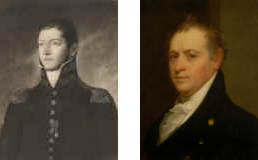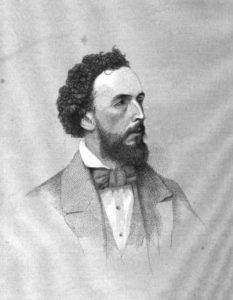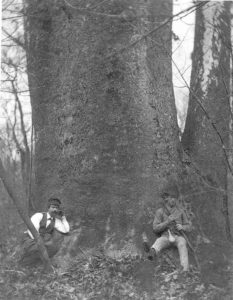Historic Writings
Early explorer John Filson made a trip to Vincennes in 1785/6 and returned to the Falls of the Ohio by the Buffalo Trace. Even at that time he noted commercial use of the trace taking place.
The Northwest Ordinance of 1787 provided for the survey, sale, and development of the lands north and west of the Ohio River. Although there had been some white settlement in Ohio, these ordinances were a major step in opening Ohio and Indiana to pioneers.
The pioneers were fueled with imagination and exaggeration. “Lord love us, that Indiana soil is so rich you hafta coat yer corn seed in axel grease or the plants’ll burn themsevles up shootin outta th ground,” one wrote.
Wildlife and the rich resources also encouraged more settlement. The French fur traders wrote that Indiana was the center of the finest game region in the country. Pelts from the posts in the Indiana territory brought in 8,000 pounds of sterling in one year– apparently an exorbitant amount of income for the time.
Read about the travels of John Heckewelder, a Moravian missionary, during the late 1700s.

The 1804 Treaty of Greenville had secured the land south of the trace for the new United States. Despite the treaty, Native American tribes were still a major threat, one of many on the trace for those hardy pioneers who now began to move up the trace to make homes in the newly available lands. Many immigrants from Virginia, North Carolina and Tennessee had been waiting in Kentucky for the lands to be opened for settlement, and began to pour into the wilderness. They came on horseback, others in carts and others in wooden wheel wagons drawn by horse or oxen. Some brought their families; others came first, cleared some land, built a cabin or lean-to, and went back to bring the family.
Food was, for the most part, caught along the way, and was plentiful. Bear, deer, turkey, and buffalo were mainstays. The only alternative to meat was usually ash cakes made from bear grease and ground meal. Nuts, berries and persimmons could be had at some times of the year.

David Thomas traveled the Trace in 1816. These are notes he took from his travel journal:1
- Leaving Louisville we traveled 40 mile, told the well water was unfit, supped upon buttermilk.
- Next day horses suffering from sore feet, only managed 20 mile, breakfasted at Salem.
- Many locals from the Carolines, complain about “miserable cold weather”.
- Our host bitten by copperhead some months ago & was scarcely recovered…. Told that the poison of this reptile lingers a long time in the system & eventually proves destructive to the constitution.
- Arrived at ‘french licks’, observed the springs—-. This place is a favorite residence of the ‘parroquet’, flocks of which continually fly around. These birds seem to delight in screaming.
- Arrived at ‘Schultzs’ near the driftwood branch of the white river. Saw fish in great numbers—I could take them up by handfuls.
- Traveled 36 miles, poor deserted country, miserable huts, poor accommodations, high charges.
- Every man his own hostler & steward. Inhabitants generally possess a small share of politeness.
- Traveled 25 miles through woods, passed four houses.
Richard Lee Mason, also kept a journal on the Trace in 1819:2
- Nov 3, passed thru shipping port, (on the Ohio) twelve or thirteen steamboats lying around due to unusual drought.
- Passed through New Albany—traveled to millers a distance of twelve miles over the knobs. The woods being on fire, a scene truly sublime at night (white & red man burned woods in the fall).
- Slept in a house without glass in the windows & no fastenings on the doors… The inhabitants imprudent and lazy beyond example. Supped on cabbage, turnips, pickles, beets, pickled beef, rye coffee and sage tea.
- Slept in a cabin with three wagons. The house not close enough to keep the cats & dogs out.
- Traveled twenty five miles, with great difficulty obtained water for the horses.
- Passed one of the most miserable huts seen. —a log pen laid as for hogs. Contained a young & “interesting” female, her two shivering, starving children, small bed one blanket, & a few potatoes. We shared some bread, cheese & toddy.
- In this part of the country the woods are large—abundance of bears, wolves, wildcats and panthers.
- Made a distance of thirty four miles. (Slept) at this dirty hovel, one room and loft formed by boards placed three inches apart (this is Nov.). There were thirteen in the family & ten travelers. Supped on pumpkins, cabbages, rye coffee without sugar, bones of venison, salted pickles —all in the midst of crying children, dirt, filth & misery.
- No water, no food fit to eat, dusty roads, and constantly enveloped on a cloud of smoke due to the woods being on fire for 100 miles.
- Arrived at Vincennes on the Wabash, a bold & handsome river. Vincennes, an ancient town, is small, ugly & meanly built—. Its inhabitants are French, Americans, and Native Americans—in short, people from the four corners of the earth.

Read George R. Wilson’s description of the Buffalo Trace in Dubois County


